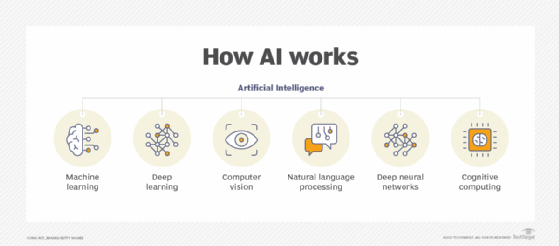Artificial Intelligence as a Service (AIaaS) represents a paradigm shift in how businesses access and leverage the power of AI. Instead of investing heavily in infrastructure, specialized personnel, and complex software development, companies can now consume AI capabilities on a pay-as-you-go basis, much like cloud computing. This democratization of AI allows organizations of all sizes to experiment with and implement AI solutions without the significant upfront costs and technical hurdles traditionally associated with it. This readily available access to Artificial Intelligence as a Service opens doors to innovation and efficiency gains across various industries.
Understanding the Core Components of AIaaS
AIaaS platforms typically offer a suite of pre-trained AI models, development tools, and infrastructure resources. These components can be categorized as follows:
- Pre-trained AI Models: These are ready-to-use AI models trained on vast datasets, capable of performing tasks such as image recognition, natural language processing, and predictive analytics.
- Development Tools: AIaaS platforms provide tools for building, training, and deploying custom AI models, catering to more specific business needs.
- Infrastructure: The underlying infrastructure, including servers, storage, and networking, is managed by the AIaaS provider, eliminating the need for companies to invest in and maintain their own hardware.
Benefits of Adopting AIaaS
The adoption of AIaaS offers a multitude of benefits for businesses, including:
- Reduced Costs: Eliminates the need for significant upfront investments in hardware, software, and specialized personnel.
- Faster Time to Market: Allows businesses to quickly deploy AI solutions without the lengthy development cycles associated with traditional AI implementations.
- Increased Scalability: Provides the flexibility to scale AI resources up or down as needed, based on changing business demands.
- Access to Expertise: Offers access to the expertise of AI specialists and researchers employed by the AIaaS provider.
- Focus on Core Business: Frees up internal resources to focus on core business activities rather than AI infrastructure management.
Specific Use Cases for AIaaS
AIaaS finds applications across a wide range of industries and use cases. Some notable examples include:
- Customer Service: Implementing AI-powered chatbots to handle customer inquiries and provide 24/7 support.
- Marketing: Utilizing AI for personalized marketing campaigns and targeted advertising.
- Fraud Detection: Employing AI to identify and prevent fraudulent transactions.
- Predictive Maintenance: Leveraging AI to predict equipment failures and optimize maintenance schedules.
- Healthcare: Using AI to analyze medical images and assist in diagnosis.
AIaaS vs. Traditional AI Implementation: A Comparison
| Feature | AIaaS | Traditional AI Implementation |
|---|---|---|
| Cost | Lower upfront costs, pay-as-you-go | High upfront costs, significant infrastructure investments |
| Time to Market | Faster deployment | Longer development cycles |
| Scalability | Highly scalable | Limited scalability |
| Expertise | Access to provider’s expertise | Requires in-house AI expertise |
| Management | Provider managed | Internally managed |
FAQ: Frequently Asked Questions About AIaaS
Q: Is AIaaS suitable for small businesses?
A: Yes, AIaaS is particularly well-suited for small businesses due to its low upfront costs and ease of use.
Q: What level of technical expertise is required to use AIaaS?
A: The level of technical expertise required varies depending on the complexity of the AI solution. However, many AIaaS platforms offer user-friendly interfaces and pre-trained models that require minimal technical knowledge.
Q: How secure is AIaaS?
A: AIaaS providers typically implement robust security measures to protect data and ensure compliance with industry regulations.
Q: What are the potential drawbacks of using AIaaS?
A: Potential drawbacks include vendor lock-in and dependence on the AIaaS provider’s infrastructure and services.
Q: How do I choose the right AIaaS provider?
A: Consider factors such as the provider’s expertise, pricing, security measures, and the specific AI capabilities offered when selecting an AIaaS provider.
Artificial Intelligence as a Service (AIaaS) represents a paradigm shift in how businesses access and leverage the power of AI. Instead of investing heavily in infrastructure, specialized personnel, and complex software development, companies can now consume AI capabilities on a pay-as-you-go basis, much like cloud computing. This democratization of AI allows organizations of all sizes to experiment with and implement AI solutions without the significant upfront costs and technical hurdles traditionally associated with it. This readily available access to Artificial Intelligence as a Service opens doors to innovation and efficiency gains across various industries.
AIaaS platforms typically offer a suite of pre-trained AI models, development tools, and infrastructure resources. These components can be categorized as follows:
- Pre-trained AI Models: These are ready-to-use AI models trained on vast datasets, capable of performing tasks such as image recognition, natural language processing, and predictive analytics.
- Development Tools: AIaaS platforms provide tools for building, training, and deploying custom AI models, catering to more specific business needs.
- Infrastructure: The underlying infrastructure, including servers, storage, and networking, is managed by the AIaaS provider, eliminating the need for companies to invest in and maintain their own hardware.
The adoption of AIaaS offers a multitude of benefits for businesses, including:
- Reduced Costs: Eliminates the need for significant upfront investments in hardware, software, and specialized personnel.
- Faster Time to Market: Allows businesses to quickly deploy AI solutions without the lengthy development cycles associated with traditional AI implementations.
- Increased Scalability: Provides the flexibility to scale AI resources up or down as needed, based on changing business demands.
- Access to Expertise: Offers access to the expertise of AI specialists and researchers employed by the AIaaS provider.
- Focus on Core Business: Frees up internal resources to focus on core business activities rather than AI infrastructure management.
AIaaS finds applications across a wide range of industries and use cases. Some notable examples include:
- Customer Service: Implementing AI-powered chatbots to handle customer inquiries and provide 24/7 support.
- Marketing: Utilizing AI for personalized marketing campaigns and targeted advertising.
- Fraud Detection: Employing AI to identify and prevent fraudulent transactions.
- Predictive Maintenance: Leveraging AI to predict equipment failures and optimize maintenance schedules.
- Healthcare: Using AI to analyze medical images and assist in diagnosis.
| Feature | AIaaS | Traditional AI Implementation |
|---|---|---|
| Cost | Lower upfront costs, pay-as-you-go | High upfront costs, significant infrastructure investments |
| Time to Market | Faster deployment | Longer development cycles |
| Scalability | Highly scalable | Limited scalability |
| Expertise | Access to provider’s expertise | Requires in-house AI expertise |
| Management | Provider managed | Internally managed |
Q: Is AIaaS suitable for small businesses?
A: Yes, AIaaS is particularly well-suited for small businesses due to its low upfront costs and ease of use.
Q: What level of technical expertise is required to use AIaaS?
A: The level of technical expertise required varies depending on the complexity of the AI solution. However, many AIaaS platforms offer user-friendly interfaces and pre-trained models that require minimal technical knowledge.
Q: How secure is AIaaS?
A: AIaaS providers typically implement robust security measures to protect data and ensure compliance with industry regulations.
Q: What are the potential drawbacks of using AIaaS?
A: Potential drawbacks include vendor lock-in and dependence on the AIaaS provider’s infrastructure and services.
Q: How do I choose the right AIaaS provider?
A: Consider factors such as the provider’s expertise, pricing, security measures, and the specific AI capabilities offered when selecting an AIaaS provider.
Navigating the AIaaS Landscape: Key Considerations
Before diving headfirst into AIaaS, it’s crucial to approach the decision with a strategic mindset. Think of it as embarking on a journey – you need a map and a compass. Here’s some advice:
- Define Your Objectives: What specific business problems are you trying to solve with AI? Clearly defining your goals will help you identify the right AIaaS solutions. Do you need to improve customer service response times, predict sales trends, or automate repetitive tasks? A clear objective will guide your selection process.
- Assess Your Data: AI models thrive on data. Evaluate the quality, quantity, and accessibility of your data. Is your data clean, structured, and readily available? If not, you’ll need to invest in data preparation before you can effectively use AIaaS. Also consider data privacy regulations and choose providers that adhere to relevant compliance standards.
- Evaluate Integration Capabilities: Ensure that the AIaaS platform can seamlessly integrate with your existing IT infrastructure and applications. A smooth integration process will minimize disruption and maximize the value of your AI investments. Look for providers that offer APIs and connectors for popular platforms.
- Understand Pricing Models: AIaaS providers offer various pricing models, such as pay-per-use, subscription-based, and tiered pricing. Carefully evaluate the pricing structure and choose a model that aligns with your usage patterns and budget. Don’t be afraid to negotiate and ask for customized pricing plans.
- Prioritize Security and Compliance: Data security is paramount. Choose an AIaaS provider with robust security measures and a proven track record of protecting sensitive data. Ensure that the provider complies with relevant industry regulations, such as GDPR and HIPAA.
Mitigating Potential Risks
While AIaaS offers numerous benefits, it’s essential to be aware of potential risks and take steps to mitigate them. Here’s how to stay on course:
- Avoid Vendor Lock-In: Choose AIaaS providers that offer open APIs and support for industry standards. This will make it easier to switch providers in the future if necessary. Consider a multi-cloud strategy to diversify your AIaaS investments and reduce reliance on a single vendor.
- Monitor Performance and Costs: Continuously monitor the performance of your AIaaS solutions and track your spending. This will help you identify areas for optimization and ensure that you’re getting the most value from your investments; Implement dashboards and alerts to proactively identify and address any issues.
- Upskill Your Team: Invest in training and development programs to equip your team with the skills needed to effectively use and manage AIaaS solutions. This will empower your employees to leverage AI to its full potential and drive innovation.
- Establish Clear Governance Policies: Develop clear governance policies for the use of AIaaS, including guidelines for data privacy, security, and ethical considerations. This will help you ensure that AI is used responsibly and ethically within your organization.
Future Trends in AIaaS
The AIaaS market is constantly evolving, with new technologies and innovations emerging all the time. Keep an eye on these trends:
- Edge AI: Deploying AI models closer to the data source, enabling faster processing and reduced latency.
- Explainable AI (XAI): Developing AI models that are more transparent and easier to understand, promoting trust and accountability.
- AutoML: Automating the process of building and training AI models, making AI more accessible to non-experts.
- AI-powered Cybersecurity: Using AI to detect and prevent cyber threats, enhancing security posture.
By carefully considering these factors and staying informed about the latest trends, you can successfully navigate the AIaaS landscape and unlock the transformative power of AI for your business. Always remember that careful planning and due diligence are key to a successful AIaaS implementation.


